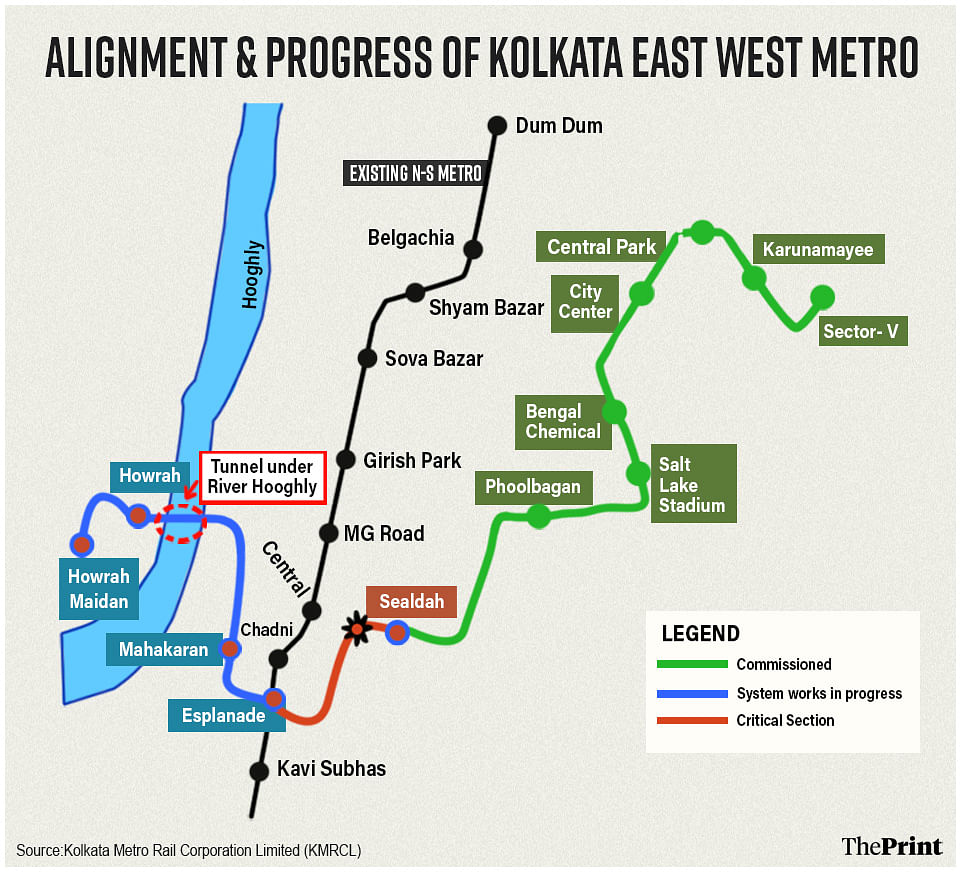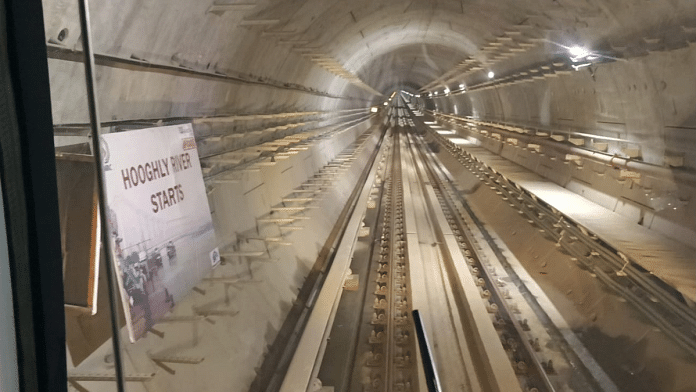Howrah: Buildings 150 years old, erratic soil structure and underground aquifers prone to flooding are just some obstacles the Kolkata Metro Rail Corporation (KMRC) has overcome while building India’s first underwater metro tunnel linking the cities of Kolkata and Howrah across the Hooghly river.
The underwater tunnel is 520 metre in length and is located at a depth of 16 metre below the riverbed. Trains on the metro line part of the East-West Metro Corridor in Kolkata will pass through it in just 45 seconds.
Falling in the section that will connect Howrah Maidan and Esplanade metro stations (4.80 km), the tunnel is almost complete and the section is set to be opened for commercial services by December this year.
“The tunnel is part of the longer east-west corridor (Green Line) that covers 16.55 km, with metro trains running at 80 km per hour. It is expected to cut down the commute between Howrah and Kolkata’s Salt Lake City from 1-1.5 hours by road to 30-40 minutes,” Shailesh Kumar, General Manager of KMRC, which comes under the Ministry of Railways, told ThePrint.

Built at a cost of Rs 10,442 crore, the East-West Metro Corridor in Kolkata starts from Sector 5 of Salt Lake City, an IT hub, and ends at Howrah Maidan on the other end of the city across the Hooghly river.
There are 12 metro stations along the corridor route — Howrah Maidan, Howrah Station, BBD Bagh (Mahakaran), Esplanade, Sealdah and Phoolbagan, all underground, and Salt Lake Stadium, Bengal Chemical, City Centre, Central Park, Karunomoyee and Salt Lake Sector 5, all of which are elevated.
“The 9.3 km stretch from Salt Lake City’s Sector 5 to Sealdah is already in operation and the stretch between Howrah Maidan and Esplanade is set to open in December. After that, the focus would be on opening the critical section between Esplanade and Sealdah stations, where work is currently in progress,” Kaushik Mitra, Chief Public Relations Officer (CPRO) of Eastern Railway, told ThePrint.
The entire east-west corridor including the 2.45 km Esplanade-Sealdah section is expected to be completed by June 2024, according to the KMRC.
Senior officials from KMRC told ThePrint that they faced numerous challenges in building the underground tunnels for the metro line, not just in the section that runs through the perennial river but in other sections as well where structures like the Bankim Setu (a flyover of Howrah) stand.
“The Howrah Maidan to Esplanade underground corridor goes through a heavily built-up area of Kolkata, where there is also a lot of traffic congestion. Then, of course, putting the tunnel below the Hooghly river was difficult as it contains water the year around and the pressure varies there because of the fluctuating depth of water,” Sanjay Banerjee, General Manager (Civil), KMRC, told ThePrint.
“Fortunately, no untoward incident happened during the construction of the tunnels.”
Planning & working around obstacles
The underwater tunnel was built in a record 66 days, connecting the Howrah station complex on the western bank to Armenian Ghat in the east, according to the KMRC.
Banerjee explained that when digging work was started for the tunnel, the first layer of soil was deemed unfit for construction.
This was because water could easily drain through it as opposed to the clay layer, which is composed of the smallest particles of soil which are densely packed with little or no airspace.
Fortunately, clay soil was found in the second layer and the tunnel could be built, he added.
“The depth of the underwater tunnel is 16 metre below the riverbed at the deepest location, and the water depth averages 30 metre, which varies during low tide, high tide and wet and dry seasons,” said Mitra. “It averages to 12 humans standing on top of each other.”
Talking about the ventilation system for the underground network, Shamim Ahmed, General Manager, Electrical, KMRC, told ThePrint that the KMRC team analysed the database of maximum and minimum temperature and humidity in the city, on the basis of which the system was designed.
“A linear heat detection system is in place in the tunnel, so if temperature rises beyond 45 degrees Celsius, an alarm is set off and urgent action can be taken if required. Additionally, there is a mechanism to regulate smoke and for fire-fighting and sprinkling systems, according to international norms,” he said.
Ahmed said no water was diverted in the process of making the tunnel and waterproofing had been done to avoid incidents of flooding or leakage.
According to the KMRC, emergency evacuation pathways are also available in the tunnels with exit arrangements at Howrah Station and Strand Road.
Also Read: 40 technicians, screw jacks & lot of devotion — how Railways ensures Puri Rath Yatra stays on course
A stitch in time
Despite the precautions and planning, the KMRC team and workers did face challenges in the process of constructing the underwater tunnel and section of the metro line that passes through congested areas along the Brabourne Road in Burrabazar.
Banerjee explained that a millemetre-by-millemetre land survey had to be conducted for the construction of the underground tunnels so as to not infringe upon the foundation of the Bankim Setu. This was done with help from ‘earth pressure balance tunnel-boring machines’.
Apart from the Bankim Setu, there was the Brabourne Road flyover which starts at Howrah bridge. Again, the metro tunnels had to be built below it without affecting the bridge’s foundation.
“We encountered 150-year-old buildings on the alignment. During the construction of underground tunnels, these buildings had to be checked for any shift or tilt. If not corrected in time, the entire structure could collapse. As a matter of abundant precaution, people living there had to be shifted temporarily,” said Kumar.
Last year, underground water seepage caused cracks in 12 buildings at Madan Dutta Lane in Kolkata’s Bowbazar (in the section between Sealdah and Esplanade), according to media reports.
“Between Sealdah and Esplanade, we came across the worst challenge because we encountered a peculiar type of aquifer which led to flooding in tunnels on three different dates and three locations. This challenge has nearly been overcome after we worked on it by taking advice from foreign consultants,” said Banerjee.
Kumar added that in places “tunneling was required below big yards like the ones at Howrah and Sealdah, and careful planning had to be undertaken for the same”.
A project long in making
In 1984, Kolkata became the first city in India to get a metro line that covered 3.4 km (Esplanade and Bhowanipore) over the north-south axis. The corridor was later extended and currently runs from Dakshineswar to New Garia (now Kavi Subhash) over 31.3 km with 26 stations.
Aditya Chaudhary, CPRO of South Eastern Railway, told ThePrint that the east-west corridor joins the existing north-south metro network at Esplanade station and would boost connectivity.
“Right now, there are two road bridges that connect Howrah and Kolkata. But during rush hours, these two ways are not enough and suffer from a lot of congestion. The new metro network will be helpful and could see a footfall of 30,000 commuters daily,” he said.
The east-west metro corridor would also connect train travellers getting off at Howrah railway station to the entire metro network.
ThePrint had earlier reported how Kolkata’s east-west corridor has been 100 years in the making as it was first planned by the then British administration in 1921.
“The underwater tube rail in Kolkata was planned by the British government when they were building a tunnel under the Thames river in London. However, after a soil test in Kolkata, they dropped the idea — the project cost was six times higher than the one they built in London,” Aloke Kumar, associate professor at IIM-Calcutta, had told ThePrint.
The project was taken up again after Independence in 1969 by B.C. Roy’s Congress government and was supported by then prime minister Indira Gandhi.
Roy’s government, however, chose a north-south corridor to build India’s first metro rail, in collaboration with the Indian Railways. Construction could finally begin only in 1978, with the project continuing to face delays and political hurdles.
In 2008, the United Progressive Alliance-I government sanctioned the East-West Metro Corridor in Kolkata, at an estimated cost of Rs 4,754 crore. The foundation stone was laid in 2009 and the first section on the line (Sector 5 to Sealdah) became operational in 2020.
“In the initial stage when construction was in full swing, about 200 engineers were working on it round-the-clock, along with 15,000 labourers,” said KMRC General Manager Kumar.
He added that “the line is being built jointly by Japan International Cooperation Agency (JICA) and KMRC, with 48 per cent cost borne by JICA and the balance by the government of India. Experts from both JICA and KMRC are providing expertise”.
(Edited by Nida Fatima Siddiqui)
Also Read: Delhi’s had a ‘bhawan’ boom, but era of ‘decentralised’ govt buildings could end with Central Vista



